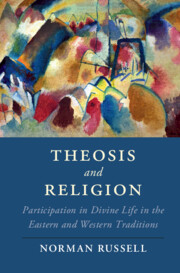Book contents
- Theosis and Religion
- Cambridge Studies in Religion, Philosophy, and Society
- Theosis and Religion
- Copyright page
- Dedication
- Contents
- Preface
- Abbreviations
- Introduction
- 1 What Is ‘Religion’, What Is ‘Theosis’, and How Are They Related?
- 2 Byzantium
- 3 The Latin Heirs of Dionysius
- 4 ‘Light the Lamp within You’
- 5 ‘People Will Be Gods’
- 6 ‘The Via Regia’
- 7 One with God
- 8 Afterword
- Bibliography
- Index
1 - What Is ‘Religion’, What Is ‘Theosis’, and How Are They Related?
Published online by Cambridge University Press: 07 March 2024
- Theosis and Religion
- Cambridge Studies in Religion, Philosophy, and Society
- Theosis and Religion
- Copyright page
- Dedication
- Contents
- Preface
- Abbreviations
- Introduction
- 1 What Is ‘Religion’, What Is ‘Theosis’, and How Are They Related?
- 2 Byzantium
- 3 The Latin Heirs of Dionysius
- 4 ‘Light the Lamp within You’
- 5 ‘People Will Be Gods’
- 6 ‘The Via Regia’
- 7 One with God
- 8 Afterword
- Bibliography
- Index
Summary
The first chapter explores the meaning of religion - which is much broader than the belief-system of any given ecclesial communion - and also the meaning of theosis in its early historical development. Religion is considered up to the early modern age but theosis only to the end of the patristic age as the springboard for the study of later developments as they relate to religion.
Keywords
- Type
- Chapter
- Information
- Theosis and ReligionParticipation in Divine Life in the Eastern and Western Traditions, pp. 9 - 33Publisher: Cambridge University PressPrint publication year: 2024

